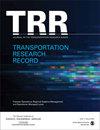Service Quality in Rail Systems: Listen to the Voice of Social Media
IF 1.8
4区 工程技术
Q3 ENGINEERING, CIVIL
引用次数: 2
Abstract
Service quality is essential to increase and maintain user loyalty to the railway system. In the literature, surveys have been used to measure user satisfaction, and mathematical methods have been applied to quantify the survey results. In recent years, user-generated content, including comments and complaints shared via social media, has been used to measure the quality of rail services. This content may provide important insights into the quality of the service provided with its dynamic structure. In this study, a SERVQUAL-based social-media analytics approach is used to measure railway service quality, placing special emphasis on the temporal variations in a national rail system. Topic modeling was used to assign each content item to the relevant service dimension and sentiment analysis was applied to measure the level of satisfaction. Importance–performance analysis was employed at the final stage to generate policy suggestions. Gathering more than 2.3 million social-media messages posted from 2011 to 2021, we examined the temporal evolution of service quality of the Turkish rail system. The results reveal the most and least important services and the satisfaction level of each dimension. The differences between the priorities of conventional and high-speed rail passengers are defined, and policy recommendations are presented.铁路系统的服务质量:倾听社会媒体的声音
服务质量对于提高和保持用户对铁路系统的忠诚度至关重要。在文献中,调查被用来衡量用户满意度,并应用数学方法来量化调查结果。近年来,用户生成的内容,包括通过社交媒体分享的评论和投诉,已被用来衡量铁路服务的质量。该内容可以提供对其动态结构提供的服务质量的重要见解。在本研究中,采用基于servqual的社会媒体分析方法来衡量铁路服务质量,特别强调了国家铁路系统的时间变化。使用主题建模将每个内容项目分配到相关的服务维度,并使用情感分析来衡量满意度。在最后阶段采用重要性-绩效分析来产生政策建议。我们收集了2011年至2021年发布的230多万条社交媒体信息,研究了土耳其铁路系统服务质量的时间演变。结果揭示了最重要和最不重要的服务以及每个维度的满意度。定义了普通铁路和高铁乘客优先级之间的差异,并提出了政策建议。
本文章由计算机程序翻译,如有差异,请以英文原文为准。
求助全文
约1分钟内获得全文
求助全文
来源期刊

Transportation Research Record
工程技术-工程:土木
CiteScore
3.20
自引率
11.80%
发文量
918
审稿时长
4.2 months
期刊介绍:
Transportation Research Record: Journal of the Transportation Research Board is one of the most cited and prolific transportation journals in the world, offering unparalleled depth and breadth in the coverage of transportation-related topics. The TRR publishes approximately 70 issues annually of outstanding, peer-reviewed papers presenting research findings in policy, planning, administration, economics and financing, operations, construction, design, maintenance, safety, and more, for all modes of transportation. This site provides electronic access to a full compilation of papers since the 1996 series.
 求助内容:
求助内容: 应助结果提醒方式:
应助结果提醒方式:


